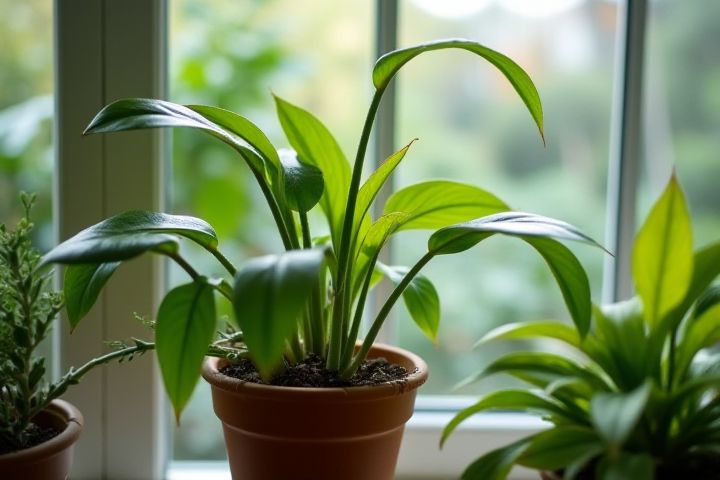
To maximize light exposure for your house plants, position them near south-facing windows, which receive the most sunlight throughout the day. If space allows, use shelves or plant stands to elevate smaller plants, ensuring they capture adequate light without being overshadowed by larger varieties. Consider the unique light conditions of each room, as east-facing windows provide gentle morning light, ideal for shade-loving species. For plants that thrive in bright, indirect light, placing them a few feet away from direct sunlight can prevent leaf burn. Remember to rotate your plants regularly to ensure uniform growth and healthier foliage.
Where To Place House Plants For Best Light
Near south-facing windows
Positioning house plants near south-facing windows provides optimal light exposure due to the sun's trajectory, yielding around 6 to 8 hours of direct sunlight daily. This location enhances plant growth and vibrancy, particularly for light-loving species like succulents and flowering plants. To maximize light absorption, ensure your plants are 1 to 3 feet away from the window, avoiding direct contact with glass which can lead to overheating. Regularly rotate your plants every few weeks to encourage even growth and prevent leaning towards the light source.
Close to east-facing windows
For optimal growth, place your house plants close to east-facing windows, where they will receive gentle, morning sunlight. This exposure typically provides a balanced light spectrum that promotes healthy foliage without the risk of scorched leaves from harsh afternoon sun. Positioning plants within 2 to 3 feet of the window ensures they absorb sufficient bright, indirect light, essential for photosynthesis. Regularly rotating your plants can also help maintain even growth by allowing all sides to benefit from the available light.
Away from direct sunlight
Position house plants in bright, indirect light to promote healthy growth without the risk of sunburn. East-facing windows are ideal, as they provide gentle morning sunlight while being shielded from the harsh afternoon rays. If you only have south or west-facing windows, use sheer curtains to filter the direct light. For plants that thrive in lower light conditions, consider placing them 6-10 feet away from windows or in rooms with fluorescent lighting for optimal health.
On windowsills with indirect light
Placing house plants on windowsills is ideal for maximizing exposure to indirect light, especially in spaces that receive soft, filtered sunlight. This position allows plants like pothos or peace lilies to thrive without the risk of leaf burn from harsh direct rays. You should aim for windows facing east or north, as they typically provide gentle morning or afternoon light. Maintaining a distance of at least 2-3 feet from the window can help ensure your plants receive the optimal light intensity for healthy growth.
In bright, filtered light areas
Position your house plants in bright, filtered light areas, as this enhances their growth and vitality. Ideally, place them near east-facing windows, where morning sunlight provides gentle illumination without causing leaf scorch. You can also use sheer curtains to diffuse direct sunlight while still allowing essential light to reach your plants. When selecting space, ensure that they receive at least 4 to 6 hours of filtered light daily for optimal health and flourishing foliage.
Consider plant's light requirements
Placing house plants in locations that match their specific light needs is crucial for their health. For example, succulents and cacti thrive in bright, direct sunlight and should be positioned near south-facing windows. On the other hand, ferns and snake plants prefer indirect light and can flourish in areas with filtered light from sheer curtains or farther from windows. By assessing each plant's light requirement, you can maximize their growth potential and enhance your living space.
Rotate plants for even growth
Position house plants near windows that receive indirect sunlight, as this offers optimal light exposure without the risk of leaf scorch. A south-facing window is ideal for many species, providing at least 6 hours of light daily. To achieve even growth, rotate your plants 90 degrees every few weeks, ensuring that all sides receive equal light. Monitor your plants for signs of light deficiency or excess, adjusting their placement as needed for their specific light requirements.
Avoid drafty spots
To maximize the light for your house plants, position them near windows that receive bright, indirect sunlight for several hours a day. Avoid drafty spots such as areas near air conditioning vents or drafty windows, as temperature fluctuations can stress plants and hinder their growth. South-facing windows are usually optimal, providing ample light, while east-facing windows can offer gentle morning sun. Consider using sheer curtains to diffuse harsh sunlight for sensitive species, ensuring optimal light exposure without the risk of leaf burn.
Use sheer curtains to diffuse light
Place houseplants near windows that receive bright, indirect sunlight for optimal growth. Utilizing sheer curtains can effectively diffuse harsh sunlight, allowing your plants to thrive without the risk of leaf scorch. East-facing windows typically offer moderate morning light, ideal for many houseplant varieties. Ensure you rotate your plants every few weeks to promote even growth and prevent them from leaning towards the light source.
Monitor plants for light stress
Place house plants near east or west-facing windows to provide them with optimal light exposure, as these directions offer gentle morning or evening sunlight. Monitor your plants for signs of light stress, such as scorched leaves or excessive stretching toward the light source, indicating that adjustments may be necessary. Consider using sheer curtains to diffuse strong sunlight, reducing the risk of leaf burn while still providing adequate brightness. Rotate your plants every few weeks to ensure even light distribution, promoting balanced growth across all sides.
